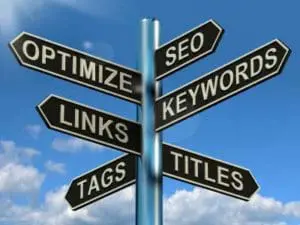
Even though it accounts for only about 25% of how search engines score and rank your website, it is worth making it the first step of your SEO strategy since it is easy enough to do and provides almost immediate improvement.
Off-Page SEO refers to your site’s “authority” on the Internet, which is determined by what other websites “say” about your site. Off-page SEO is about getting your site to the top of the list of search results, and usually takes time to improve.
7 elements of on-page optimization
1. Page Title is one of the most important on-page SEO factors. The title is the text you see at the top of your browser window when viewing a webpage. It is also the title of a page that is presented in search engines.
It can be found and edited in your site’s HTML code. (HTML is the back-end code of your website that search engines read.) The text surrounded with the <title> tag is your page’s title.
To produce effective page titles:
- Include keywords
- Make it fewer than 70 characters long. Any longer, and it will cut off at 70 characters. A too-long title also dilutes the importance of the keywords used.
- Put keywords as close to the beginning of the title as possible.
- Make it readable for site visitors.
- Include your business name at the end of the title.
- Use a different page title for each page of your website — it’s an opportunity to target different keywords.
2. Meta Description is an often overlooked opportunity to attract search visitors. The meta description is not visible on the web page itself. It is a summary of the page included in the source code, usually at the top of the page. It provides a short description (less than 150 characters) of the page beneath the result the search engine returns for the given search terms.
A well-worded meta description attracts a searcher’s attention and indicates if the result is particularly relevant to the searcher. For this reason, including your keywords in the description helps to draw in visitors, even though it doesn’t directly affect search engine rankings. In a survey conducted by Hubspot, almost 50% of respondents said their
number one indicator of whether that page is relevant to them is the description of the page in the search results.
Have you ever noticed that sometimes you see a clip of the page content under the search engine result link, with the search terms you used bolded in the text? If the meta description is missing, the search engine usually displays a selection of the page content instead. That happens when there is no meta description in the source code for that page. What you want your visitors to see is the description you choose to show them, not what the search engine thinks might be relevant.
3. Headings are the text that appears larger and more prominent than other text on the page. Heading text is more likely to be read by search engines as keywords than main body text. Thus it is good to include keywords in your headings whenever possible. A Heading1 tag gives the text more weight as a keyword than a Heading2 tag; similarly a Heading2 tag gives more weight than a Heading3 tag.
Because Heading4 and Heading5 tags have little more importance than regular text, you want to avoid using them, since including too many headings dilutes the importance of keywords in other headings. We recommend using only ONE Heading1 on a page. If you have a lot of text, like in a blog post, you could use a few Heading2 or Heading3 tags as section and paragraph titles.
4. Images enhance the user experience. They can illustrate points you want to make and provide a visual picture of your company. Keep in mind:
- If you use images excessively, your page will take longer to load. This not only has a negative impact on search engine optimization, it also makes the user experience less friendly.
- Search engines do not read images, only text, so make sure you associate some text with the image. If you add the HTML attribute called ALT-text to your image, search engines will be able to read the associated text.
- Include keywords in the image file name to attract targeted traffic from image searches. Separate different keywords in the file name with a dash (-).
5. Domain Registration – Sites that have been registered for a longer period of time rank higher. Domains that are registered or renewed for a longer interval indicate that you have a commitment to the site, so they have less chance of being considered spam. Next time your domain name comes up for renewal, consider extending the registration for several years to boost SEO.
6. MozRank is a general measure of how much “authority” your site has — the more authority, the higher the rank. MozRank factors both on-page and off-page SEO to rank websites. The on-page SEO discussed in this section contributes about 25% to that ranking. (We’ll get to off-page SEO in the next section.) It is calculated on a logarithmic scale, so it’s easier to get from a 3 to a 4 than from an 8 to a 9. You can find your rank and more information at http://www.seomoz.org/learn-seo/mozrank.
7. URL Structure – Your web address is also called a URL. The URL structure specifies how the different URLs associated with a website connect with each other. Improving URL structure is one of the more difficult aspects of optimization.
Apply a 301 redirect where needed to forward an old URL to the new one. Also apply one between YourSite.com and www.YourSite.com. If you fail to do this, search engines will consider the two versions of your site name to be separate sites.
Avoid using deeply nested URLs — for example, yoursite.com/about/management/contact/phone. We recommend using no more than 3 levels to get higher SEO credit.
Include keywords in your URLs. Don’t buy a new domain just for this, but do clean up the URLs of your interior pages to include keywords and be easier to read.
Separate keywords with dashes for internal page URLs.
Make sure your URLs are static rather than dynamic. This means that the URL for each of your pages is always the same. Check one of your interior pages at different times using different browsers. If the URL changes from one checkpoint to another, you will need to create static URLs with your web server software.
Improving off-page SEO
As mentioned before, on-page SEO accounts for only about 25% of overall search engine ranking. The remaining 75% comes from off-page SEO, which is based on your “authority” on the Internet. So that begs the question: How do you GET authority? Authority is based on what other websites “say” about yours. OK, great, then how do websites “say” anything about other websites?
One of the main ways to get authority is to increase the inbound links to your site. An inbound link is code on another website that links to yours. These links help to increase your search engine rankings. Links from authoritative websites mean more than links from sites that have low traffic and readership (i.e. low authority).
It used to be difficult to get inbound links. Now that content is king it’s become much easier. Other sites will naturally want to link to yours when you create valuable content on a regular basis. You can improve your chances of attracting those links by sharing your content in social media and optimizing it for search results so searchers can easily find it.
Also get links from your trade associations, local newspapers, chambers of commerce and other membership sites you belong to.
You can also check our premium B2B SEO services to accelerate your traffic, leads, and sales.
